|
A-26B Invader
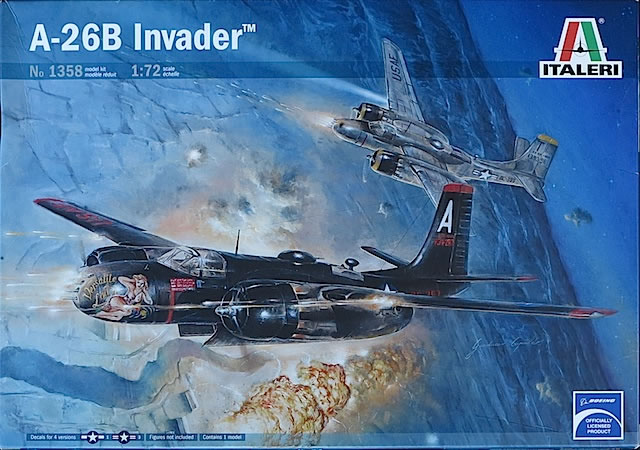
Italeri, 1/72 scale
S
u m m a r y |
| Catalogue Number: |
Italeri Kit No. 1358 – A-26B Invader. |
| Scale: |
1/72 |
| Contents and Media: |
Approximately 111 grey plastic parts (20 unused); 4 clear plastic parts; 1 decal sheet containing markings for 4 aircraft; 10 page fold-out instruction booklet with black and white painting and marking guide |
| Price: |
From GBP £22.92 plus shipping available online from Hannants |
| Review Type: |
FirstLook |
| Advantages: |
Well moulded with mostly high levels of detail throughout; interesting marking options.. |
| Disadvantages: |
Minor errors in decals and painting and marking guide; prominent ejector pin marks on many parts; minimal detail in wheel wells. |
| Conclusion: |
This kit is a welcome addition to Italeri’s 1/72 A-26/B-26 family. These kits are without doubt the best option if you are considering a 1/72 Invader and with four boxings now available (five if you include the Revell A-26B) you can choose from almost all major variants – highly recommended. |
Reviewed by Brad Fallen

Eduard's 1/48 scale Spitfire Mk.IXc Weekend Edition is available online from Squadron.com
The Douglas A-26 Invader was designed to succeed the A-20 Havoc and first flew in June 1942. Development was protracted, and the Invader’s mid-1944 combat debut inauspicious. But with most of the bugs ironed out, and tactics adapted to suit A-26 capabilities, the type saw extensive and successful use in the final year of World War 2. Invaders remained in United States service for another 25 years and served other nations beyond this, with the last Indonesian B-26 retiring in 1977.
The first major subtype was the A-26B, comprising 1,350 of the 2,450 Invaders built. A-26Bs carried six, and later eight, .50 caliber guns in a solid nosed strafer configuration and made up most of the Invaders assigned to USAAF units in Europe from mid-1944. The same was true in the Pacific although the A-26 build-up here was slower, with the Fifth Air Force’s 3rd Bombardment Group the main unit to use Invaders against the Japanese. After the war 3rd BG Invaders were based in Japan as part of the Allied occupation forces, and from there took part in some of the earliest actions of the Korean War.
Italeri launched its 1/72 A-26/B-26 family in 2005 with a well-received B-26K Counter Invader kit. In reviewing the kit on Hyperscale, Brett Green concluded that
Italeri's B-26K Counter Invader looks like one of their nicest 1/72 scale efforts to date. It is well detailed, perfectly moulded, boasts restrained surface features, has plenty of ordnance and marking options, should be quite easy to build straight from the box and will look impressive when finished.
Negatives included a lack of detail in the main gear bays, and a number of features including cockpit, wheels, tail, and crank cases appropriate to earlier A-26 models.
It wasn’t surprising, therefore, that Italeri’s next releases were glass-nosed A-26C and six-gun nosed A-26A/B kits, for which these features were applicable. These kits also included parts not contained in the B-26K kit such as earlier style cowlings and propeller blades. In 2007 Revell used essentially the same sprues to release an A-26B eight-gun strafer kit, which was reviewed here.
Now Italeri has also released an eight-gun A-26B, with markings for one Pacific and three Japan-based 3rd BG aircraft.
The box art depicts two of the kit’s marking options attacking ground targets in Korea. Inside the box are four sprues of grey plastic (two identical) and one clear sprue containing four parts. The parts count of 115 does not seem large for a 1/72 twin-engined bomber, particularly when 20 parts aren’t needed and go straight into the spares bin. Unused parts include underwing gun pods and one of the ventral turret blanking options.
Brett’s praise for the quality of the mouldings in the original B-26K kit holds true for this boxing. The fuselage and wing halves, particularly, are well moulded with a smooth finish and consistent engraved and raised detail. The parts don’t have the finesse of the latest Tamiya or Eduard mouldings – the panel lines are not as refined, and there is a little flash here and there – but they are still very acceptable. All control surfaces are moulded integrally in a neutral position, with ailerons and flaps moulded entirely on the upper wing halves for ease of assembly and to ensure thin trailing edges.
Test assembly of the main airframe components reveals perfectly fitting fuselage halves and a reasonable join between of the upper and lower wing halves. Dry fitting the assembled wing to the fuselage suggests a little work will be required to achieve a perfect join here.
There are lots of ejector pin marks on the plastic parts, many in places that will make them tricky to remove without damaging surrounding detail, but visible on the finished model if left untreated. The gear bays remain bare as described by Brett, and even a little scratch detailing here will make a difference to the appearance of your finished model. The engines are also slightly basic. In contrast the detail elsewhere – in crew stations and nose gear and bomb bays – is reasonable to good, including in some places that will be invisible when the model is built.
I’m not convinced the wheels are 100 per cent accurate for an A-26B – they seem to be slightly generic – but several styles of wheel were fitted so check your references.
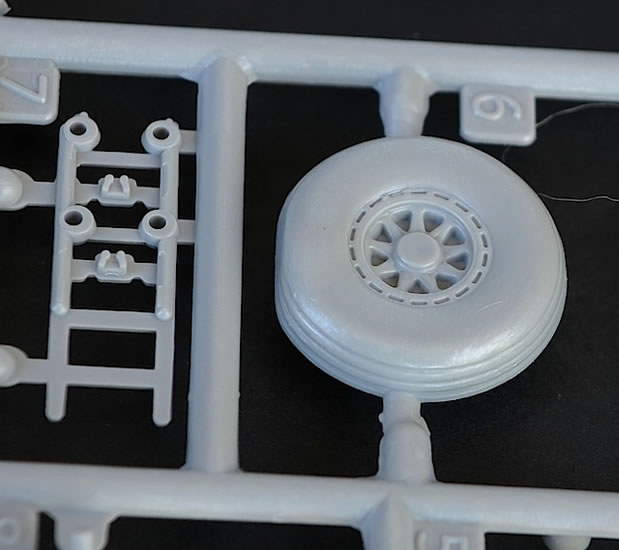
The vortex generators on the starboard fin are not appropriate for the kitted marking options (they were present on B-26Ks but not 1940s-era Invaders), but this is pointed out in the instructions and the generators will be easy to sand off.
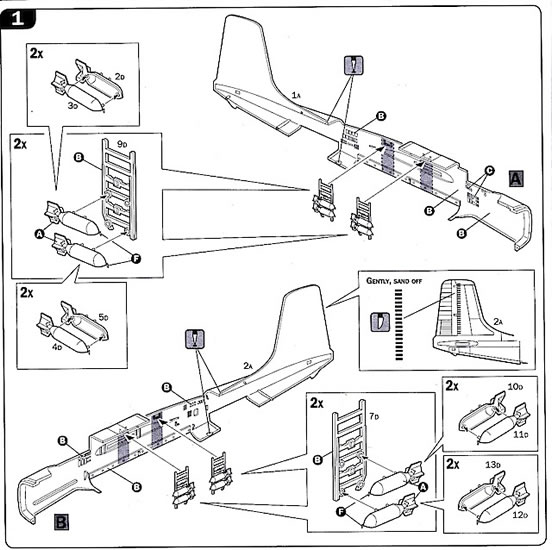
The contours of the eight-gun nose look ok, and Italeri’s approach of moulding the guns as two four-weapon parts that are inserted through the nose from the inside virtually guarantees correct alignment.
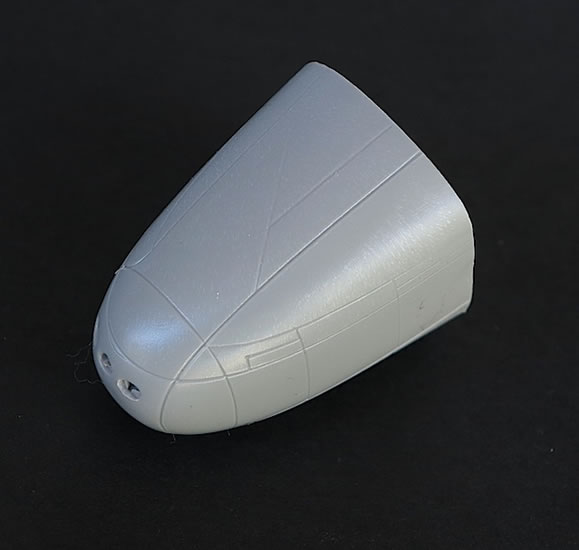
Optional parts include ventral turrets and wing guns, which were not fitted to all marking options. The choices are clearly set out in the instructions, and the kit is engineered in such a way that you don’t need to make a final decision on marking choice until near the end of your build.
I don’t like the fold out format that Italeri uses for its instructions – I always seem to be folding and re-folding the five double-sided A4 pages to find the section I want – but these are otherwise quite good. Construction is presented clearly through 13 well-illustrated steps, with some useful tips provided along the way (for example, there is a diagram to assist with setting correct dihedral for the tailplanes). I do question Italeri’s recommendation of building the wings in their entirety (complete with propellers and undercarriage) before adding them to the fuselage – common sense would suggest they should be attached at an earlier stage of construction!
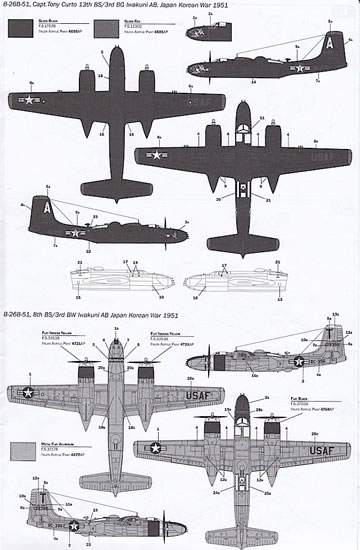
Paint call-outs are included at every step, in both US Federal Standard and Italeri Acrylic numbers. The black-and-white painting and marking guide is disappointing compared to other recent Italeri releases such as their 1/48 Spitfire Mk.Vc and P-47D, which contained very well done full-colour guides.
Marking Options
Decals are provided for the following Invaders:
-
B-26B-51-DL, serial 44-34287/‘Versatile Lady’, flown by Captain Tony Curto of the 13th Bombardment Squadron, 3rd Bombardment Group, Iwakuni, Japan, 1951. This well-known B-26 was finished in overall black with red tipped wings and tail surfaces, and carried the titular semi-nude figure and the skeleton-and-scythe emblem of the 13th BS on opposite sides of the nose. Italeri’s rendition of the ‘Versatile Lady’ is a good match for photos of the real painting, although the blue stripes in the background of the decal art may be slightly too pronounced.
-
B-26B (the instructions suggest B-26B-51 but my research indicates B-26B-30-DL), serial 41-39396, 8th BS, 3rd Bombardment Wing, Iwakuni, Japan 1951. Lost with its crew on a night mission over Korea on 13 June 1951, 41-39396 was finished in overall natural metal (or possibly silver paint, according to one source). The yellow and black engine cowlings and yellow-tipped vertical tail surfaces supplied splashes of colour. I haven’t been able to find a reference photo of this machine; Italeri depicts it and the following B-26 with ventral turrets.
-
A-26B-51-DL, serial 44-34298 (not 44-34289 as printed on the decal sheet), 89th BS, 3rd Bombardment Group, Mindoro, Philippines, 1945. An often-published photo shows 44-34298 slightly the worse for wear after a belly-landing; one of the details worth noting is the heavy exhaust staining flowing over and under the wing surfaces. This and the following aircraft were camouflaged in Olive Drab over Neutral Gray; 44-34298 also had green-and-white tipped vertical tail surfaces.
-
A-26B-56-DL, serial 44-34377, flown by Lieutenant Dwight Turner of the 8th BS, 3rd BG, Atsugi, Japan, 1947-48. According to Martin Simpson’s Douglas A/B-26 site, this aircraft was subsequently lost over North Korea in September 1951. The tip of the vertical tail surfaces on 44-34377 was yellow and white.
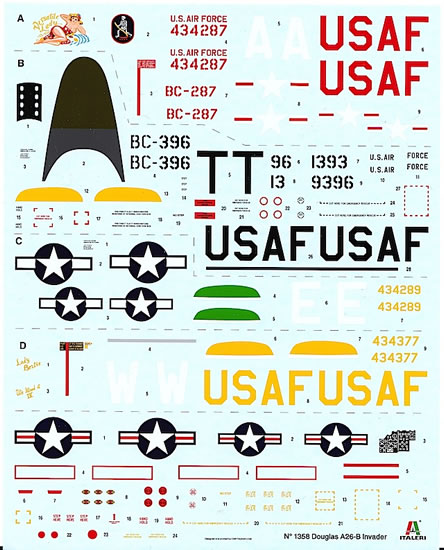
The decals are by Cartograf and have been printed to this company’s usual high standard; I can find no flaws of any kind on the sheet. Decals are supplied for the cockpit instruments and also the anti-glare panel on marking option B. However, I would probably paint the latter, along with the yellow, green and white and yellow and white fin tip decals for options B, C and D.
Italeri’s A-26B Invader kit is a welcome addition to its 1/72 Invader family. The A-26/B-26 is my favourite US twin-engined aircraft, with its good looks and proven effectiveness across a number of conflicts. Over the years I have accumulated several of the 1/48 Monogram kits and associated conversions, but the Invader is a big model in this scale and despite some grand plans I have yet to build one (or seen many built in contests). However a 1/72 Invader is a different prospect: small enough to easily build and handle, but still big enough to make an impression. Italeri’s kits are without doubt the best option if you are considering a 1/72 A-26, and with four boxings now available (five if you include the Revell A-26B) you can choose from almost all major Invader variants.
Highly recommended!
References:
-
Frederick A. Johnsen, WarbirdTech Volume 22: Douglas A-26 Invader (Specialty Press, 1999)
-
Jim Mesko, A-26 Invader in Action (Squadron Signal Publications, 1980)
-
Jim Mesko, Douglas A-26 Invader Walk Around (Squadron Signal Publications, 2008
-
Martin Simpson’s Douglas A/B-26 site
Thanks to The Hobby Company Limited for the sample
Review Text and Images Copyright © 2014 by Brad Fallen
Page Created 19 August, 2014
Last updated
19 August, 2014
Back to HyperScale Main Page
Back to Reviews Page |
